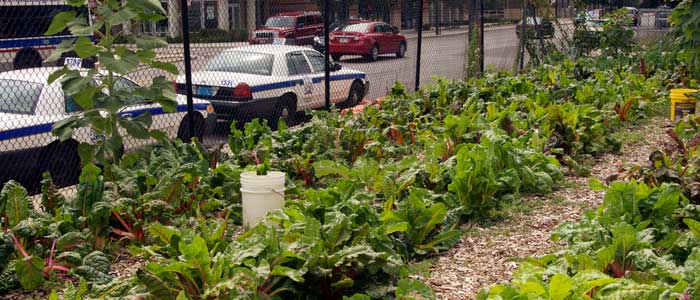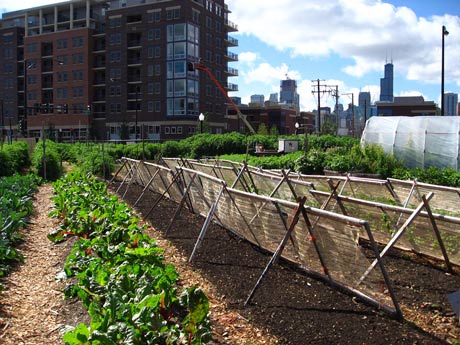Across the street from a Dominick’s, City Farm’s farm stand is doing intermittent business, with passersby picking up boxes of carrots, turnips, heirloom tomatoes, bunches of kale or basil. It’s impossible to ignore the juxtaposition: the small farm standing defiantly next to the big. Inside there, I assume I’d find the same basic layout of any Dominick’s in the city, possibly the country: fluorescent lights, neat displays of fruits and vegetables, aisles full of prepackaged and processed food.
Here, racks of multi-colored tomatoes sit in crates, and the shifting breeze brings the heady smell of basil with it, mixed with the less-delightful odor of car exhaust. Volunteers in dirt-stained jeans, wearing straw sun-hats and baseball caps, kneel down on mulched rows, pulling weeds. Customers, or interested parties like myself, wander amidst the rows, snapping pictures of kale and collard greens on their phones. In one corner, laying hens cluck and peck at the ground, snapping to expectant attention when I walk by, then losing interest when I don’t offer food.
City Farm, a project of the Resource Center has been in its current location since 2005, on the corner of Clybourn and Division in the Near North Side, on the border of the Gold Coast and Cabrini Green neighborhoods. From 2000-2005, the farm was situated where a group of squat concrete buildings now stand. The farm is designed to be, according to its website, “a moveable feast,” a farm that can be relocated with a minimum of waste and energy. The land is owned by the city, specifically by the Chicago Housing Authority. Until recently, much of the vacant land around the farm was home to the infamous Cabrini-Green housing projects. With the buildings’ destruction, the neighborhood is attempting to reinvent itself, to shake off its history as a model of urban blight.

Ten years on, the old housing projects have been mostly demolished, with large grassy fields and glitzy advertisements for new condos taking their place. City Farm has been a part of that reinvention, though Ken Dunn, one of the founders of the project, was quick to assure me that City Farm and the Resource Center don’t endorse the consequences of gentrification. City Farm settled into the neighborhood twenty years ago because of the number of vacant lots, and because of its unique location on the border between an affluent area and an impoverished one. Cabrini-Green provided the space and the work force for the farm, while Gold Coast and the Near North provided markets.
Under my feet, I’m told by Dan Hurowitz, one of the farm’s staff, is a layer of clay, with three feet of compost and soil on top of it. When the city terminates City Farm’s lease, they’ll simply pack the whole operation up and move it elsewhere, soil and clay included. Hurowitz calls the farm “semi-permanent”. Moreover, the farm is part of a closed system of recycling: the Resource Center picks up food waste from the same restaurants that they sell their veggies to, and use them for large-scale composting that goes back into the farm. Using these or other methods, City Farm and the Resource Center believe that Chicago is capable of producing most of its own food. Not only that, Ken Dunn explains, but urban agriculture is a cost-effective way of revitalizing neighborhoods like Cabrini-Green, with beautification and job-creation.

City Farm sells a good portion of their harvest to high-end restaurants and upscale markets, such as Frontera, Vie and the Signature Room. Hurowitz estimates that sales to restaurants cover the majority of the costs of running the farm, keeping the prices of veggies at their farm stand and market stall competitive with the Dominick’s across the street, never mind the Whole Foods a few blocks away. Even better, workers at the farm stand will harvest veggies to order: hand over a list of what you want, and they’ll pull it out of the ground while you wait.
City Farm plans to stay in the Cabrini-Green neighborhood, possibly moving to one of the larger adjacent lots. They are also planning to create another farm in the Washington Park next season.
Besides dropping in for a visit, which I definitely recommend, you can buy directly from City Farm with their CSA at the Logan Square farmer’s market, at Green Grocer or Dill Pickle Co-op.